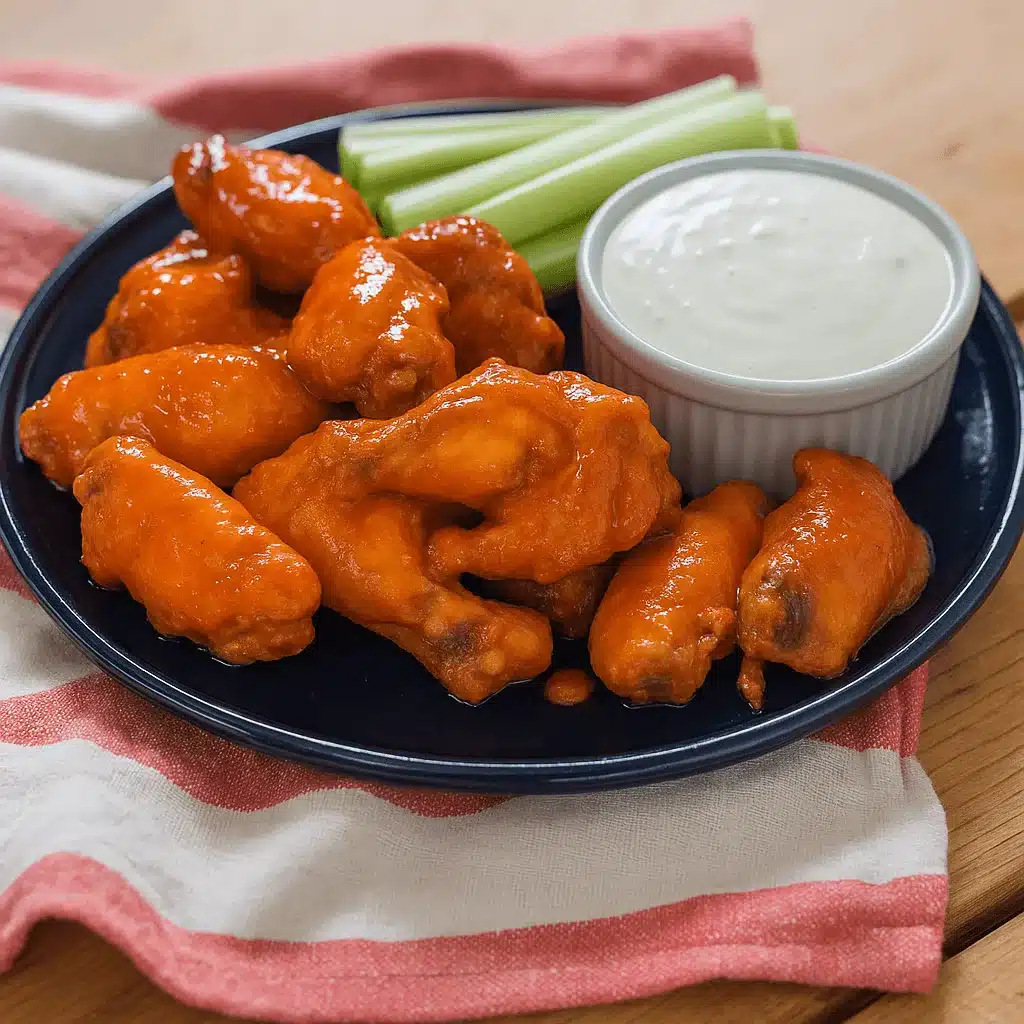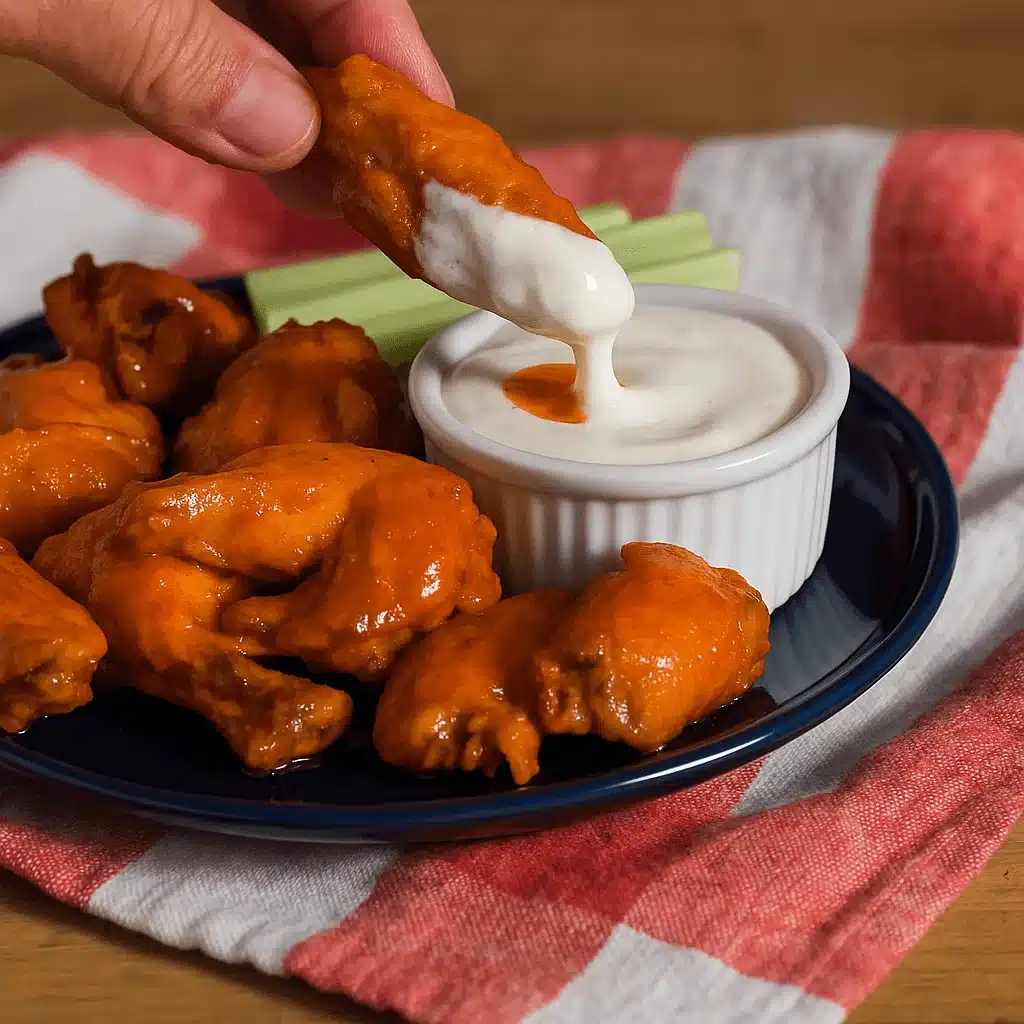Sous vide chicken wings changed how I cook one of my all-time favorite comfort foods. One hectic weeknight in Austin, after chasing two kids and a deadline, I needed something easy, high-protein, and flat-out delicious. That’s when sous vide wings became my secret weapon.
After years of testing recipes that balance comfort and nutrition, I found that sous vide offers unbeatable control over texture and flavor. These wings come out impossibly juicy inside with a golden, crispy finish—every time. Whether you’re prepping for game day or meal prepping for the week, this guide will walk you through the process step by step.

You’ll learn which temperature to use for fall-off-the-bone wings, how long to cook them, and why this method is worth the time. Plus, we’ll troubleshoot common issues, explore sauce options, and give you a printable recipe card.
Table of Contents
Table of Contents
Why Choose Sous Vide for Chicken Wings?
What Makes Sous Vide Chicken Wings So Unique?
Unlike traditional cooking, which often leaves wings dry or uneven, sous vide chicken wings are gently cooked to the perfect temperature in a water bath. This locks in moisture, breaks down collagen, and creates tender meat that stays juicy—even in the drumettes, which tend to dry out fast.
Whether you’re using separated parts or going for whole chicken wings, the sous vide method ensures every bite is evenly cooked, flavorful, and packed with moisture.
The magic happens in two stages: low-temp sous vide cooking followed by high-heat crisping. This combo ensures a silky interior and crackly skin—something you just can’t fully achieve with baking or air frying.
Is Cooking Chicken Wings Sous Vide Really Worth It?
For many, the idea of spending hours on wings might seem like overkill. But with sous vide chicken wings, most of that time is hands-off. Set the temp, drop in your seasoned wings, walk away—and come back to perfectly cooked meat. Finish them in hot oil or a skillet, and you’re done.
Compared to double-frying or baking, sous vide gives slightly better texture and flavor, especially when prepped in advance. The result is wings that impress without the stress.

Sous Vide Chicken Wings
Ingredients
- 4 pounds (1.8 kg) chicken wings, cut into drumettes and flats, wing tips removed
- Kosher salt, to taste
- 8 tablespoons (1 stick / 110 g) unsalted butter
- 1 cup (235 ml) Frank's RedHot Sauce
- 3 quarts (2.8 L) peanut or canola oil (for frying)
- Blue cheese dressing, for serving
- Celery sticks, for serving
Instructions
- Set Up the Immersion Circulator: Set up an immersion circulator and preheat the water bath to either 160°F (71°C) if you want fall-off-the-bone wings or 165°F (74°C) if you want juicy and tender wings that still retain some springiness.
- Meanwhile, season wings all over with salt. Place wings in zipper-lock bags (you may need multiple bags to easily hold all the wings). Alternatively, slide wings into vacuum bags and seal according to vacuum-sealer manufacturer's instructions. If using zipper-lock bags, seal using the water-displacement method. Add bagged wings to immersion circulator and cook for 2 hours if cooking at 160°F or 1 hour if cooking at 165°F.
- Remove wings from bags and pat dry; discard juices. Arrange wings on wire racks set on rimmed baking sheets and refrigerate, uncovered, for 8 hours or up to 2 days.
- When ready to serve, in a small saucepan, combine butter and Frank's and cook over medium-low heat, stirring occasionally, until butter is completely melted. Transfer to a large bowl.
- Meanwhile, in a wok or Dutch oven, heat oil to 400°F (205°C). Working in small batches, carefully add chicken and cook, stirring and flipping occasionally while adjusting heat to maintain a temperature of 375 to 400°F (190 to 205°C), until golden brown and crisp, about 3 minutes per batch. Using a spider or slotted spoon, transfer wings to paper towels to drain. When all the wings have been fried, transfer to bowl with sauce, toss to coat, and serve with blue cheese dressing and celery.
Nutrition
Sous Vide Chicken Wings Texture Breakdown
How Sous Vide Keeps Chicken Wings Juicy and Tender
The real magic of sous vide chicken wings lies in their texture. This method gently cooks the wings in a water bath, slowly breaking down collagen while locking in moisture. The result? Incredibly tender meat that stays juicy and never dries out—unlike wings cooked with direct high heat.
Sous vide delivers consistent, juicy results—just like Crispy Chicken Nuggets, but with bold, saucy wing flavor.
Drumettes vs Flats: Sous Vide Wins Every Time
Drumettes often dry out faster than flats because of their lower fat content. But with sous vide, that problem disappears. Both cuts cook at the same temperature and pace, creating consistent tenderness throughout.
To help you visualize it better, here’s a simple comparison:
| Cut | Texture (Traditional) | Texture (Sous Vide) |
|---|---|---|
| Drumettes | Can dry out easily | Juicy, tender, never stringy |
| Flats | More forgiving, but less meaty | Evenly cooked, full of moisture |
| Both (combo) | Often uneven results | Balanced, consistent texture |
Whether you’re serving a crowd or just making a batch for yourself, sous vide chicken wings deliver maximum tenderness with zero guesswork.
Best Temperature and Time Settings for Sous Vide Wings
Ideal Sous Vide Temperatures: 145°F, 160°F, 165°F, 185°F
Getting the perfect sous vide chicken wings is all about choosing the right temperature for your taste. Different temps create noticeably different textures, from springy and juicy to fall-off-the-bone tender. Here’s a quick breakdown of the most effective ranges:
- 145°F (63°C) for 2.5 hours – Super juicy, with a firmer bite. Not fully fall-off-the-bone.
- 160°F (71°C) for 2 hours – Tender, moist, and pulls cleanly from the bone. Great balance.
- 165°F (74°C) for 1 hour – Soft but springy texture. Ideal for those who want just a bit of chew.
- 185°F (85°C) for 1 hour – Ultra tender and fall-apart. Great for shredding or boneless-style wings.
Each setting works, depending on your goal. Want the meat to glide off the bone? Choose 160°F for 2 hours. Prefer wings with a little more structure? Go with 165°F for a shorter cook.
How Long to Sous Vide Wings Based on Desired Texture
Time matters just as much as temperature. Longer cooks result in deeper collagen breakdown, which creates that silky, almost confit-like tenderness. Shorter cooks retain more texture and bite.
| Temperature | Time | Result |
|---|---|---|
| 145°F | 2.5 hours | Juicy, slightly chewy |
| 160°F | 2 hours | Tender, pulls off the bone cleanly |
| 165°F | 1 hour | Juicy with a slight springiness |
| 185°F | 1 hour | Very soft, fall-apart meat |
Sous vide chicken wings let you cook for texture—not just doneness. That’s a huge upgrade from guessing in the oven or fryer.
Step-by-Step Process for Cooking Sous Vide Chicken Wings

Prepping and Bagging Wings for Circulation
To start your sous vide chicken wings, begin with fresh or thawed wings. Cut them into flats and drumettes if they’re whole, and remove wing tips (you can save those for stock).
Season the wings generously with kosher salt. From here, you have two options:
- Vacuum-seal them using a vacuum sealer, or
- Use zipper-lock freezer bags and the water displacement method: lower the bag slowly into the water bath to push out the air before sealing it.
Arrange wings in a single layer to ensure even cooking. Overcrowding the bag can prevent proper heat circulation.
Water Bath Settings and Cooking Duration
Fill your container with water and set your immersion circulator to your chosen temperature. For most, 160°F for 2 hours is the sweet spot for tender, juicy, fall-off-the-bone wings.
Here’s a quick reference:
| Preferred Texture | Temp | Time |
|---|---|---|
| Soft and springy | 165°F | 1 hour |
| Very tender and juicy | 160°F | 2 hours |
| Ultra soft | 185°F | 1 hour |
Once the wings are in, they cook on autopilot. This is one of the best parts of cooking sous vide chicken wings—no flipping, poking, or checking. Just let them go.
After cooking, remove the wings from the bags, discard any juices, and pat them completely dry with paper towels.
The Art of Air-Drying and Finishing Your Wings
Why Air-Drying Is Crucial Before Crisping
Once your sous vide chicken wings are cooked, they’ll be tender and juicy—but the skin will be soft and damp. To get that crave-worthy crispiness, you need to remove surface moisture before frying or searing.
Here’s how:
- Pat wings dry thoroughly with paper towels.
- Place them on a wire rack set over a baking sheet.
- Leave them uncovered in the fridge for at least 8 hours, or up to 2 days.
This air-drying step allows the skin to dehydrate just enough so that when it hits the hot oil (or grill), it crisps up instantly without steaming.
Skipping this step means soggy skin and longer cook times, which can undo the tenderness you just worked so hard to create.
Best Methods to Finish Wings: Fry, Grill, or Roast?
After air-drying, it’s time for the final step: crisping the skin. While you can grill or roast your wings after sous vide, only one method guarantees the crispy finish wings deserve—deep frying.
Let’s break it down:
| Method | Pros | Cons |
|---|---|---|
| Fry | Super crispy, fast, seals in moisture | Requires oil, fryer or deep pot |
| Grill | Smoky flavor, nice char | Longer time = risk of overcooking meat |
| Oven | Convenient, low mess | Less crisp, harder to control texture |
Sous vide chicken wings shine brightest when finished in 375–400°F oil for 2–3 minutes. This seals the exterior without overcooking the already-tender meat inside. Work in batches to avoid overcrowding and oil temp drops.
Buffalo Sauce and Beyond – Flavoring Your Sous Vide Wings
Classic Buffalo Sauce Preparation
You can’t talk about sous vide chicken wings without honoring the legend: Buffalo sauce. It’s the classic combo of tangy, spicy, and buttery that turns a great wing into a crave-worthy one.
Here’s the go-to recipe:
Buffalo Sauce Recipe
- 8 tablespoons unsalted butter (1 stick)
- 1 cup Frank’s RedHot sauce
- Optional: a splash of vinegar or a pinch of garlic powder for depth
Melt the butter over medium-low heat, stir in the hot sauce, and whisk until fully blended. Toss the freshly fried wings in this sauce while they’re still hot so they absorb every drop.
It’s rich, bold, and always a crowd-pleaser—but don’t stop there.
Flavor Variations: Korean, Honey Garlic, and BBQ
One of the best things about sous vide chicken wings is their versatility. Once they’re cooked and crisped, you can coat them in just about any sauce you love. Here are a few favorites:
Korean Gochujang Wings
Sweet, spicy, and savory with a sticky glaze.
- 2 tbsp gochujang
- 1 tbsp soy sauce
- 1 tbsp honey
- 1 tsp sesame oil
- Garlic and ginger to taste
Honey Garlic Glaze
Perfect balance of sweet and tangy with aromatic garlic.
- 1/3 cup honey
- 1 tbsp soy sauce
- 2 cloves garlic (minced)
- 1 tsp cornstarch (mixed with water)
Smoky BBQ Wings
A backyard classic with a slight char if you finish them on the grill.
- Use your favorite BBQ sauce, thinned slightly with water or apple cider vinegar so it coats easily.
Whether you like your wings fiery, sticky-sweet, or smoky and rich, sous vide chicken wings give you a blank canvas for any flavor profile.
Troubleshooting Sous Vide Chicken Wings
Why Is My Sous Vide Chicken Rubbery?
Rubbery texture is one of the few things that can go wrong with sous vide chicken wings—and it usually comes down to one of two issues:
- Temperature Too Low or Time Too Short
If you cook at 145°F for under 2 hours, the collagen doesn’t break down fully, leaving meat with a dense, rubbery texture. Always follow the recommended combos like 160°F for 2 hours for tender, juicy wings. - No Drying Step Before Frying
If you skip air-drying or don’t pat the wings dry well enough, the excess moisture prevents crisping and can make the skin chewy instead of crisp. Always dry thoroughly and let wings sit on a wire rack in the fridge before finishing.
Fix: Adjust your temp/time or drying step, and make sure your wings hit hot oil fast for that crispy finish.
What to Do if Wings Are Too Soft or Overcooked
Overcooked or mushy wings typically happen if:
- You left them in the sous vide bath too long, or
- Finished them in the oven or grill instead of frying, exposing them to prolonged heat.
Even though sous vide is forgiving, there’s still a sweet spot. Going beyond 3 hours or finishing with dry heat can break the meat down too much, leading to a soft, shredded texture.
Fix: Stick to the right window (1–2 hours depending on temp), and finish in very hot oil (375–400°F) for a quick crisp without re-cooking the meat.
Quick Troubleshooting Guide
| Problem | Likely Cause | Fix |
|---|---|---|
| Rubbery wings | Temp too low / time too short | Try 160°F for 2 hours |
| Soggy skin | Not dried before frying | Air-dry in fridge at least 8 hours |
| Overcooked/mealy | Too long in water / grilled finish | Reduce sous vide time and finish in oil |
| Lack of crispiness | Oil not hot enough | Fry at 375–400°F in small batches |
Final Thoughts About sous vide chicken wings
If you’ve ever wished for chicken wings that are fall-off-the-bone tender on the inside and perfectly crispy on the outside—sous vide chicken wings are your answer. Yes, they take a little extra time and planning, but the payoff is real. You get precise control, consistent results, and restaurant-quality wings every single time. Love crispy bites like Maryland Fried Chicken? Take it up a notch with our Sous Vide Chicken Wings—ultra-juicy and fall-off-the-bone tender.
Whether you’re prepping ahead for a backyard BBQ, feeding a crowd for game day, or just treating yourself to next-level comfort food, this method checks every box: easy, high-protein, family-friendly, and completely customizable. From Buffalo to honey garlic to gochujang heat, your flavor options are endless—and delicious.
Thanks for joining me in the kitchen today. I hope this guide helps you feel confident, excited, and ready to make your best batch of wings yet. And don’t forget—always make room for seconds.
Join our foodie tribe on Pinterest—Easy Protein Kitchen shares new recipes daily!
FAQs About Sous Vide Chicken Wings
How long do you sous vide wings?
The best cooking time for sous vide chicken wings depends on your preferred texture:
160°F for 2 hours gives you fall-off-the-bone wings that are still juicy and tender.
165°F for 1 hour gives you springy, slightly firm wings with great moisture.
You can also go up to 185°F for 1 hour for ultra-soft, shred-style meat.
Stick to the sweet spot between 1 and 2 hours to avoid mushy or rubbery results.
Can I sous vide chicken at 145°F?
Technically, yes—but it’s not ideal for wings. 145°F will safely cook chicken over a longer time (at least 2.5 to 3 hours), but the texture may remain slightly rubbery or firm, especially in wings with lots of collagen.
For better results with sous vide chicken wings, start at 160°F. That temp hits the food safety zone faster and delivers better tenderness in less time.
At what temperature do chicken wings fall off the bone?
Wings begin to fall off the bone when cooked at 160°F for 2 hours or 185°F for 1 hour. These temps break down the connective tissue without drying the meat, so the wings pull apart easily but still hold their flavor and structure.
If you want wings that are juicy yet pull cleanly from the bone, 160°F is your best bet.
Why is my sous vide chicken rubbery?
Rubbery sous vide chicken wings usually come from:
Cooking at too low a temp (e.g., 145°F) without enough time
Skipping the air-drying step before crisping
Not frying at high enough heat
Fix these by using a proper time/temp combo like 160°F for 2 hours, drying wings overnight in the fridge, and frying in oil that’s 375–400°F.
